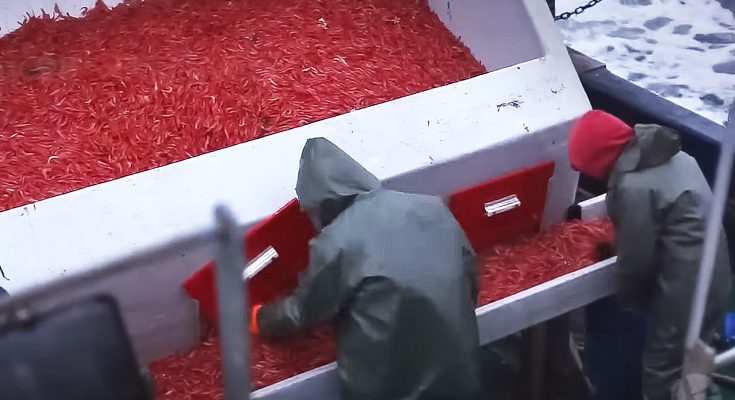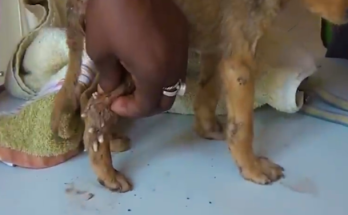Shrimp has been a culinary favorite for centuries, evolving from a difficult catch to a global staple. With the rise of farms and factories, it’s now easily accessible — peeled, frozen, and even paired with cocktail sauce. Discover the journey of this seafood from tradition to convenience.
Shrimp, whether farmed or wild-caught, is a global seafood favorite and the most consumed in the United States as of 2024. However, behind its convenience lies a meticulous process that ensures quality and safety.
Factory managers unloading a carton of shrimp to be processed. | Source: Getty Images
Understanding this journey sheds light on why shrimp is such a significant part of both local economies and international markets. Continue reading to learn more about the different ways shrimp is processed and prepared, which left social media users in awe.
Freshly caught shrimp scattered on a sidewalk to dry. | Source: Getty Images
The journey begins in two primary ways — shrimp is either farmed in controlled aquaculture environments or caught in the wild. In places like Louisiana, wild shrimping remains a vital industry, contributing $1.3 billion annually to the state’s economy as of September.
However, challenges such as rising fuel costs and competition from cheaper imports — primarily from India and Ecuador — have threatened this livelihood.
Fisherman catching shrimp in the wild. | Source: YouTube/ Business Insider
“With inflation, everything is getting more and more expensive, and running these processing plants and all this moving equipment and avoiding breakdowns takes a lot of capital,” said Kristen Baumer, a Louisiana resident and shrimp processor.
Ninety percent of the shrimp consumed in the United States comes from these international sources, underscoring the immense demand that local fisheries alone cannot meet.
People cleaning shrimp. | Source: Getty Images
On the flip side, aquaculture operations like TransparentSea, founded by longtime fisherman Steve Sutton, are revolutionizing shrimp farming. This company optimizes conditions such as feed rates and water filtration to raise shrimp more sustainably and efficiently.
By rearing 100,000 prawn larvae every three weeks, TransparentSea aimed to produce $100,000 worth of jumbo prawns in just three months.
A close-up of a shrimp. | Source: YouTube/Eater
After shrimp are caught or harvested, they must be processed quickly to preserve freshness. The process begins with a cold water rinse, ensuring the crustaceans remain clean and maintain their natural texture.
They are transported on perforated conveyors, which drain excess water and prevent them from becoming soggy. Next, shrimp are placed in plastic baskets, weighed, and transferred into larger tubs layered with crushed ice.
Shrimp being processed. | Source: YouTube/Tony 98 – Discovery
Maintaining a temperature of ten degrees Celsius or lower is crucial to ensure quality and freshness. Workers then manually remove the heads, a process requiring speed and precision. Using tools resembling open thimbles, they swiftly pull off the heads before the shrimp continue down the processing line.
Workers processing and preparing shrimp. | Source: YouTube/ Business Insider
The shrimp are sorted by size using sizing rollers with varying widths. Smaller shrimp fall through narrow gaps, while larger ones are sorted further down the line. This process ensures that shrimp are categorized into consistent sizes for packaging.
A bucket of shrimp. | Source: YouTube/ Business Insider
Once sorted, the shrimp head to the peeling and de-veining stage. Some are processed with tails intact, catering to markets that prefer easy-to-grip finger foods. Workers carefully remove the digestive tract while peeling the shell, with some achieving a production rate of approximately 800 shrimp per hour.
The shrimp are then prepared according to their intended market use. Some are dipped in egg mixtures and dredged in rice flour for spring roll appetizers, while others are coated with breadcrumbs for a crispy fried product.
Once prepared, the shrimp are flash-frozen using advanced technologies like Individually Quick Freezing (IQF). This method prevents clumping, allowing consumers to defrost only what they need.
An ice glaze is applied to protect the shrimp from freezer burn, ensuring they retain their quality until they reach the customer’s kitchen. “Outstanding” one social media user commented on a YouTube video on the production of frozen shrimp.
A close-up of a bucket of shrimp. | Source: YouTube/Tony 98 – Discovery
“I had no idea how much of shrimp processing is done by human hands,” another person shared. A third typed, “I can’t believe they do it manually 1 by 1 omg,” and a fourth typed, “The number of workers is stunning.”
The Traditional Craft of Sun-Dried Shrimp in Thailand
Sun-dried shrimp, a culinary staple in East Asia, carries a rich tradition deeply rooted in countries like Thailand. Unlike commercially dried shrimp, which often relies on machines, authentic sun-drying methods focus on natural processes, ensuring superior flavor and quality.
A man spreads shrimp along a concrete path to dry under the sun. | Source: YouTube/ KRUA dot CO
For a family-run business in Thailand, the production of sun-dried shrimp begins with careful fishing practices. Once caught, the shrimp are sorted to remove unwanted debris or undersized specimens.
A worker hand-sifts sun-dried shrimp in a woven basket, ensuring the final product meets high artisanal standards. | Source: YouTube/ KRUA dot CO
They are then thoroughly washed with seawater to preserve their natural brininess and remove impurities. The next step involves cooking the shrimp in boiling seawater.
This process, lasting no more than five minutes, is often enhanced with a touch of food coloring to maintain the shrimp’s vibrant appearance. From there, the shrimp are drained and laid out under the sun for two days, totaling approximately 12 hours of direct exposure.
Shrimp are boiled briefly in seawater to prepare them for the drying process, preserving their flavor and color. | Source: YouTube/ KRUA dot CO
The intense sunlight naturally dries the shrimp, a method that is believed to eliminate over 40 types of germs while preserving the shrimp’s authentic taste. The shell acts as a protective layer during the drying phase, preventing contamination as the shrimp rest directly on the ground.
One key distinction of sun-dried shrimp is the absence of salt in the process, which prevents excessive saltiness and highlights the shrimp’s natural flavor.
Birds gather near sun-dried shrimp, highlighting the natural and open-air environment of this traditional method. | Source: YouTube/ KRUA dot CO
Unlike commercial production, which uses ovens to accelerate the drying process, sun-drying retains the shrimp’s true essence. Ovens can unevenly dry the shrimp, leading to compromised texture and taste.
The natural heat of the sun allows the shrimp to develop a distinct depth of flavor, making them highly sought after in traditional cooking.
Workers meticulously lay out shrimp to dry under the sun, avoiding the use of machines for a more authentic flavor. | Source: YouTube/ KRUA dot CO
Once fully dried, the shells are cracked to separate them from the meat, followed by winnowing to remove dirt and scraps. The shrimp are then sorted by size, graded for quality, weighed, and packed. Each step of this hands-on process ensures that only the finest shrimp make it to the final product.
The journey of shrimp from sea to table showcases a fascinating blend of tradition and technology. While modern methods ensure mass production and convenience, artisanal practices like Thailand’s sun-drying process preserve the authentic flavors that have been cherished for generations.
Whether frozen or sun-dried, each method reflects the dedication and expertise behind this beloved seafood, reminding us to appreciate the effort that goes into every bite.



